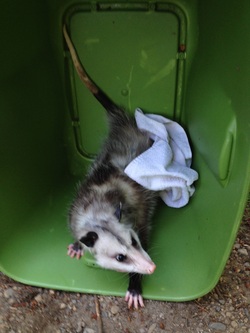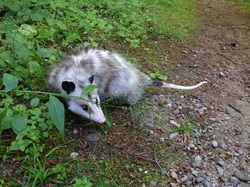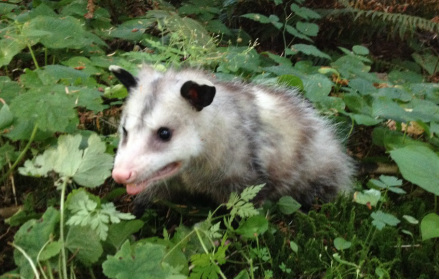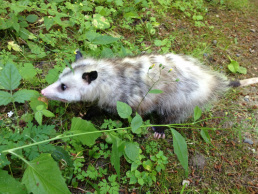Opossum Rehabilitation
- Linnea Johnson
- May 2, 2014
- 3 min read
On May 8th, 2014, South Sound Critter Care admitted an adult female Virginia Opossum that had been found in a Kent neighborhood in critical condition. After taking an x-ray, our veterinarians discovered that the opossum’s jaw was severely fractured on both the left and right sides. The next day, she was taken to the clinic for surgery, where one of the vets anesthetized her, placed two pins in both the distal and proximal parts of each side of her mandible, and wrapped her snout and jaw.
The opossum’s pre-surgery x-ray.

A radiograph taken as the pins and feeding tube were inserted.

The post-surgery radiograph.

The opossum takes the first look at her release location and new habitat.
Although the animal’s injury would heal, the road to recovery would not be an easy one; until her jaw was fully mended, she could not use it to chew and perform other daily functions. Thus, to ensure that the opossum continued to receive proper nutrition, the veterinarians implemented an esophagostomy tube, a common veterinary form of external nourishment in which a feeding tube is inserted through the mouth and exits at the neck. The tube was secured with sutures, veterinary wrap, and tape, so that it would stay in place until her jaw repaired, and the opossum’s paws were wrapped in “mittens” so that she would not remove the tube herself. For one month, our opossum was fed three to four meals per day and given pain medications, antibiotics, and anti-inflammatories through her esophagostomy tube. Additionally, she received daily subcutaneous fluids. This demanding rehabilitation process required extensive time and the gentle care of SSCC’s unpaid staff and interns. On May 13th the veterinarian replaced the two pins in the opossum’s cranial left mandible. After a few more weeks, her jaw had made significant progress and her feeding tube and mittens were replaced. On June 7th, after the opossum pulled out her own feeding tube, she was offered her first “real” food in weeks. She readily accepted bowls of water and softened kitten and dog chow, sprinkled with a supplemental calcium powder. Just over a week later, she received her third x-ray and her jaw was found to have fully healed. The critter was moved to a spacious outdoor pen, furnished with a kennel, hammocks, perches, and ample climbing room, where she was fed a varied diet of puppy chow, berries, vegetables, and smelt.
By July 7th, almost two months after her arrival, our brave opossum was finally ready for release. She weighed in at a healthy 3.35 kg (just over 7 lbs) and received well-wishes from all interns present before being placed in a transportation bin and strapped safely into my car. I drove to an access point of Soos Creek Trail, where I walked down an unpaved path for ten minutes to find the perfect spot for an opossum: a wooded area near a stream, where there are likely many more of her species nearby. At first, when I uncovered the bin and turned it on its side, the opossum seemed timid and unsure about entering this expansive, new forest habitat. However, after having curiously sniffed the soil and plants in front of her, she marched out of the box and began to explore. The opossum eagerly meandered down the path, stopping every few seconds to take in the natural sights and smells of the forest. With a bit of encouragement, she moved off the path and into the brush, sniffing her surroundings every step of the way.
The opossum explores the forest path.
After a matter of minutes had passed, she wandered into the dense greenery and was out of sight. Watching this animal confidently enter its natural habitat after having endured a painful injury and a lengthy recovery process was an immensely rewarding experience; all of our hard work to save her life had paid off. Although they are common throughout the United States, Virginia Opossums hold unique and important ecological roles. They are the only marsupials (mammals who carry their incompletely developed young in a pouch) in North America, and as mid-level predators, they help control populations of small mammals, birds, and insects, while being a food source for larger carnivores. As omnivorous scavengers, they help reduce the amount of animal carcasses in both natural and urban areas, while acting as seed dispersers for the plants they consume (“Virginia Opossum”).
This opossum’s incredible story is just one of the hundreds of injured and orphaned animal cases that end in successful release at South Sound Critter Care each year. With continued support from caring citizens like you, we will be able to carry out more medical procedures and provide greater quality of life to our patients in a constantly expanding facility. Please help make more success stories possible by donating or volunteering today!

.png)


































Comments